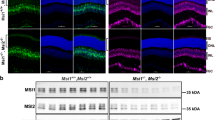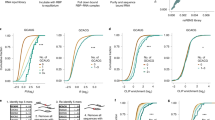Abstract
Rbpms (RNA-binding protein with multiple splicing) is a member of the RRM (RNA Recognition Motif) family of RNA-binding proteins, which is expressed as multiple alternatively spliced transcripts encoding different protein isoforms. We have shown earlier that Rbpms expression in the retina is restricted to retinal ganglion cells (RGCs), and have characterized this gene as a marker for RGCs. The aim of this study was to identify isoforms representing Rbpms in human retinas and to analyze its transcriptional regulation. We found that Rbpms is expressed as transcription variants 1 and 3 encoding isoforms A and C, respectively. These isoforms are encoded by the same first 6 exons but have different C-terminal ends encoded by exon 8 in variant 1 and exon 7 in variant 3. Computational analysis of the Rbpms 5′ untranslated and flanking regions reveals the presence of three CpG islands and four predicted promoter regions (PPRs). The effect of PPR 1 (− 1672/− 1420) and PPR2 (− 330/− 79) on transcriptional activation was minimal, whereas PPR 3 (− 73/+ 177) and PPR4 (+ 274/+ 524) induced the expression by ~ 7 and ninefold compared to control, respectively. The maximum activity, a 30-fold increase above the control level, was obtained from the construct containing both PPRs 3 and 4. Site-directed mutagenesis of several cis-elements within PPR3 and PPR4 including five for Sp1, one for AP1, and two for NF-kB showed that mutation of the first three and especially the first GC box resulted in a threefold downregulation of gene expression. AP1, NF-kB, and two downstream Sp1 sites had no significant effect on expression level. The possible involvement of the GC box 1 at position − 54 in transcriptional regulation of Rbpms was corroborated by EMSA, which showed formation of a DNA–protein complex in the presence of the oligonucleotide corresponding to this Sp1-binding site.






Similar content being viewed by others
References
Antequera F (2003) Structure, function and evolution of CpG island promoters. Cell Mol Life Sci 60:1647–1658
Bajic VB, Tan SL, Christoffels A, Schonbach C, Lipovich L et al (2006) Mice and men: their promoter properties. PLoS Genet 2:e54
Bhat SP, Rayner SA, Chau SC, Ariyasu RG (2004) Pax-6 expression in posthatch chick retina during and recovery from form-deprivation myopia. Dev Neurosci 26:328–335
Bird AP (1986) CpG-rich islands and the function of DNA methylation. Nature 321:209–213
Bird AP (1987) CpG islands as gene markers in the vertebrate nucleus. Trends Genet 3:342–347
Bock C, Walter J, Paulsen M, Lengauer T (2007) CpG island mapping by epigenome prediction. PLoS Comput Biol 3:e110
Dreyfuss G, Swanson MS, Pinol-Roma S (1988) Heterogeneous nuclear ribonucleoprotein particles and the pathway of mRNA formation. Trends Biochem Sci 13:86–91
Erkman L, Yates PA, McLaughlin T, McEvilly RJ, Whisenhunt T et al (2000) POU domain transcription factor-dependent program regulates axon pathfinding in the vertebrate visual system. Neuron 28:779–792
Gan L, Xiang M, Zhou L, Wagner DS, Klein WH et al (1996) POU domain factor Brn-3b is required for the development of a large set of retinal ganglion cells. Proc Natl Acad Sci USA 93:3920–3925
Gardiner-Garden M, Frommer M (1987) CpG islands in vertebrate genomes. J Mol Biol 196:261–282
Gehring WJ (2002) The genetic control of eye development and its implications for the evolution of the various eye-types. Int J Dev Biol 46:65–73
Gerber WV, Yatskievych TA, Antin PB, Correia KM, Conlon RA et al (1999) The RNA-binding protein gene, hermes, is expressed at high levels in the developing heart. Mech Dev 80:77–86
Glaser T, Walton DS, Maas RL (1992) Genomic structure, evolutionary conservation and aniridia mutations in the human PAX6 gene. Nature Genet 2:232–238
Glaser T, Jepeal L, Edwards JG, Young SR, Favor J et al (1994) Pax6 gene dosage effect in a family with congenital cataracts, aniridia, anophthalmia and central nervous system defects. Nat Genet 7:463–471
Glasscock E, Tanouye MA (2005) Drosophila couch potato mutants exhibit complex neurological abnormalities including epilepsy phenotypes. Genetics 169:2137–2149
Grindley JC, Davidson DR, Hill RE (1995) The role of Pax-6 in eye and nasal development. Development 121:1433–1442
Hill RE, Favor J, Hogan BL, Ton CC, Saunders GF et al (1991) Mouse small eye results from mutations in a paired-like homeobox-containing gene. Nature 354:522–525
Hörnberg H, Wollerton-van Horck F, Maurus D, Zwart M, Svoboda H et al (2013) RNA-binding protein Hermes/RBPMS inversely affects synapse density and axon arbor formation in retinal ganglion cells in vivo. J Neurosci 33:10384–10395
Jones SE, Jomary C, Grist J, Thomas MR, Neal MJ (1998) Expression of Pax-6 mRNA in the retinal degeneration (rd) mouse. Biochem Biophys Res Commun 252:236–240
Kaneko Y, Matsumoto G, Hanyu Y (1999) Pax-6 expression during retinal regeneration in the adult newt. Dev Growth Differ 41:723–729
Kim TH, Barrera LO, Zheng M, Qu C, Singer MA et al (2005) A highresolution map of active promoters in the human genome. Nature 436:876–880
Kwong JM, Caprioli J, Piri N (2010) RNA binding protein with multiple splicing: a new marker for retinal ganglion cells. Invest Ophthalmol Vis Sci 51:1052–1058
Lundquist EA, Herman RK, Rogalski TM, Mullen GP, Moerman DG et al (1996) The mec-8 gene of C. elegans encodes a protein with two RNA recognition motifs and regulates alternative splicing of unc-52 transcripts. Development 122:1601–1610
Maris C, Dominguez C, Allain FH (2005) The RNA recognition motif, a plastic RNA-binding platform to regulate post-transcriptional gene expression. FEBS J 272:2118–2131
Marquardt T, Ashery-Padan R, Andrejewski N, Scardigli R, Guillemot F et al (2001) Pax6 is required for the multipotent state of retinal progenitor cells. Cell 105:43–55
Pan L, Yang Z, Feng L, Gan L (2005) Functional equivalence of Brn3 POU-domain transcription factors in mouse retinal neurogenesis. Development 132:703–712
Piri N, Kwong JM, Song M, Caprioli J (2006) Expression of hermes gene is restricted to the ganglion cells in the retina. Neurosci Lett 405:40–45
Plaza S, Hennemann H, Möröy T, Saule S, Dozier C (1999) Evidence that POU factor Brn-3B regulates expression of Pax-6 in neuroretina cells. J Neurobiol 41:349–358
Shimamoto A, Kitao S, Ichikawa K, Suzuki N, Yamabe Y et al (1996) A unique human gene that spans over 230 kb in the human chromosome 8p11-12 and codes multiple family proteins sharing RNA-binding motifs. Proc Natl Acad Sci USA 93:10913–10917
Steinmayr M, Andre E, Conquet F, Rondi-Reig L, Delhaye-Bouchaud N et al (1998) staggerer phenotype in retinoid-related orphan receptor alpha-deficient mice. Proc Natl Acad Sci USA 95:3960–3965
Takai D, Jones PA (2002) Comprehensive analysis of CpG islands in human chromosomes 21 and 22. Proc Natl Acad Sci USA 99:3740–3745
Ton CC, Hirvonen H, Miwa H, Weil MM, Monaghan P et al (1991) Positional cloning and characterization of a paired box and homeobox containing gene from the aniridia region. Cell 67:1059–1074
Vidal M, Morris R, Grosveld F, Spanopoulou E (1990) Tissue-specific control elements of the Thy-1 gene. EMBO J 9:833–840
Walther C, Gruss P (1991) Pax-6, a murine paired box gene, is expressed in the developing CNS. Development 113:1435–1449
Wilmore HP, McClive PJ, Smith CA, Sinclair AH (2005) Expression profile of the RNA-binding protein gene hermes during chicken embryonic development. Dev Dyn 233:1045–1051
Xiang M (1998) Requirement for Brn-3b in early differentiation of postmitotic retinal ganglion cell precursors. Dev Biol 197:155–169
Young A, Jiang M, Wang Y, Ahmedli NB, Ramirez J et al (2011) Specific interaction of Gαi3 with the Oa1 G-protein coupled receptor controls the size and density of melanosomes in retinal pigment epithelium. PLoS One 6:e24376
Zearfoss NR, Chan AP, Wu CF, Kloc M, Etkin LD (2004) Hermes is a localized factor regulating cleavage of vegetal blastomeres in Xenopus laevis. Dev Biol 267:60–71
Funding
This work was supported by the National Institutes of Health (NIH) Grant EY018644 (NP).
Author information
Authors and Affiliations
Corresponding author
Rights and permissions
About this article
Cite this article
Ye, L., Gu, L., Caprioli, J. et al. RNA-binding protein Rbpms is represented in human retinas by isoforms A and C and its transcriptional regulation involves Sp1-binding site. Mol Genet Genomics 293, 819–830 (2018). https://doi.org/10.1007/s00438-018-1423-8
Received:
Accepted:
Published:
Issue Date:
DOI: https://doi.org/10.1007/s00438-018-1423-8




